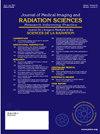Evaluation of the usefulness of the MV3D RECON technique with Bone Removal in CT Brain Angiography
IF 1.3
Q3 RADIOLOGY, NUCLEAR MEDICINE & MEDICAL IMAGING
Journal of Medical Imaging and Radiation Sciences
Pub Date : 2024-10-01
DOI:10.1016/j.jmir.2024.101530
引用次数: 0
Abstract
Purpose
The reproducibility of blood vessels in MIP 3D reconstruction of DSA images in CT brain angiography may be limited due to various factors. This study aims to analyze the factors causing image quality degradation and to evaluate the usefulness of Modified Vascular 3D Reconstruction (MV3D Reconstruction) using the bone removal technique.
Subjects and Methods
This study analyzed a total of 115 patients (52 men and 53 women) who underwent CT brain angiography at our hospital from January 23, 2023, to December 31, 2023, and experienced reduced image quality due to artifact occurrence. The Somatom Definition Force (Siemens Healthcare, Forchheim, Germany) was used as the examination device, and Syngovia (Siemens Healthcare, Germany) for image post-processing and reconstruction. Patients were divided into two groups based on the artifact type: Group A (motion) and Group B (vein reflux). The vascular reproducibility of DSA 3D reconstruction images and MV3D reconstruction images was qualitatively evaluated using a 5-point Likert scale.
Results
As a result, when MV3D Reconstruction is applied, the reproducibility of group A is 35% and group B is more than 50%. (P<0.01*)
Conclusion
Various factors contribute to the degradation of vascular image quality in CT brain angiography. The MV3D reconstruction method, incorporating the bone removal technique, improves the reproducibility of head and neck vascular images in cases of motion or venous reflux.
评估在 CT 脑血管造影中使用带骨骼切除功能的 MV3D RECON 技术的实用性
目的 CT 脑血管造影中 DSA 图像的 MIP 三维重建中血管的再现性可能会受到各种因素的限制。本研究旨在分析导致图像质量下降的因素,并评估使用去骨技术的改良血管三维重建(MV3D 重建)的实用性。研究对象和方法本研究分析了 2023 年 1 月 23 日至 2023 年 12 月 31 日期间在我院接受 CT 脑血管造影术并因出现伪影而导致图像质量下降的 115 例患者(52 例男性,53 例女性)。检查设备采用 Somatom Definition Force(西门子医疗集团,德国福希海姆),图像后处理和重建采用 Syngovia(西门子医疗集团,德国)。根据伪影类型将患者分为两组:A组(运动)和B组(静脉回流)。结果应用 MV3D 重建时,A 组的再现性为 35%,B 组超过 50%。(P<0.01*)结论多种因素导致 CT 脑血管造影中血管图像质量下降。结合去骨技术的 MV3D 重建方法提高了运动或静脉回流情况下头颈部血管图像的再现性。
本文章由计算机程序翻译,如有差异,请以英文原文为准。
求助全文
约1分钟内获得全文
求助全文
来源期刊

Journal of Medical Imaging and Radiation Sciences
RADIOLOGY, NUCLEAR MEDICINE & MEDICAL IMAGING-
CiteScore
2.30
自引率
11.10%
发文量
231
审稿时长
53 days
期刊介绍:
Journal of Medical Imaging and Radiation Sciences is the official peer-reviewed journal of the Canadian Association of Medical Radiation Technologists. This journal is published four times a year and is circulated to approximately 11,000 medical radiation technologists, libraries and radiology departments throughout Canada, the United States and overseas. The Journal publishes articles on recent research, new technology and techniques, professional practices, technologists viewpoints as well as relevant book reviews.
 求助内容:
求助内容: 应助结果提醒方式:
应助结果提醒方式:


